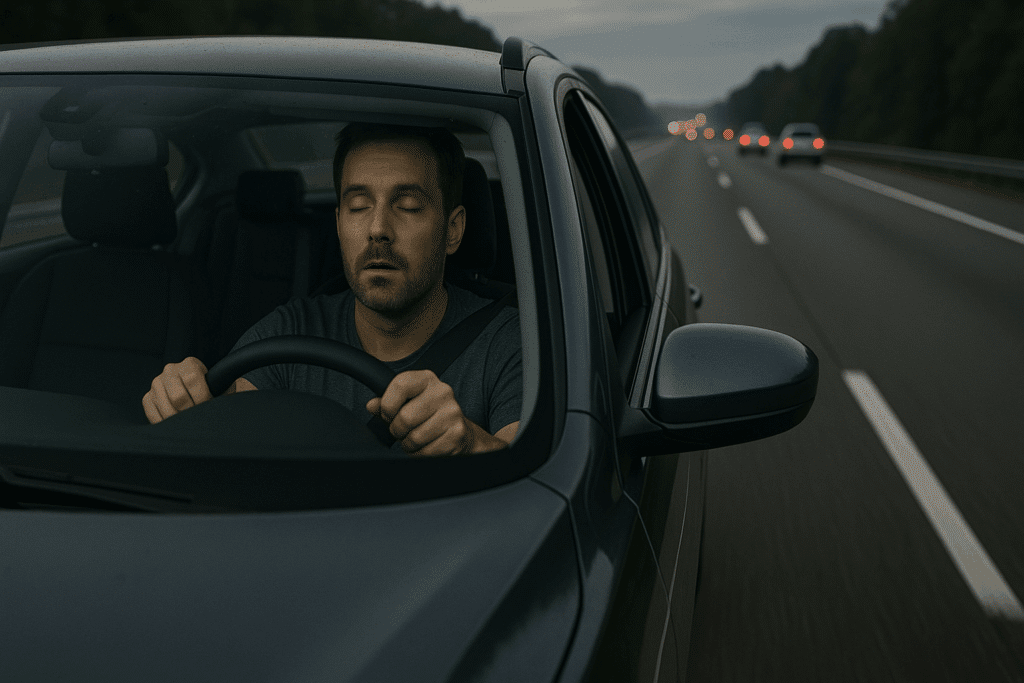Highway Hypnosis: How to Avoid White Line Fever
Updated May 13, 2025 | By Wilson Kehoe Winingham staff
If you or a loved one have been involved in a car accident or have any questions on how you can avoid highway hypnosis, contact the experienced Indianapolis car accident lawyers at Wilson Kehoe Winingham. Call us at 317.669.9983 or fill out an online contact form for a free, no-obligation case evaluation today.

Have you ever felt the sensation of driving on a long road trip or even your regular work commute when one minute you’re leaving home, and then suddenly you’ve arrived at your destination with no recollection of the time in between? When autopilot kicks in or your highway exit seems to come too soon, you have probably experienced highway hypnosis, also known as white line fever.
What Is Highway Hypnosis?
Highway hypnosis is defined as a trance-like state that drivers enter when driving for too long on an unchanging road or when navigation goes into auto-pilot. Highway hypnosis is often referred to as white line fever because the white line on the road can create a hypnotic effect, leading the driver into a state of operating in a subconscious manner.
Many times, while in a state of highway hypnosis, drivers will arrive safely at a destination with no memory of using turn signals or brakes, or noticing road signs. The hypnosis can last different periods of time, from a couple of minutes to a night of driving.
During road hypnosis, the brain is not fully aware or conscious of what is happening on the road. Reaction time is slowed, increasing the risk of an accident. Highway hypnosis is in fact considered a form of distracted driving because it can result in an accident or collision, such as running a red light or hitting the car in front of you.

Causes of Highway Hypnosis: The Science Behind the Wheel
This trance-like state of driving happens because of automaticity. When we learn how to do anything new, our brains learn the best strategy by remembering what to do and what not to do based on the success of our outcome. With automaticity, our learning turns less into remembering information and more into an automatic response.
By practicing an action repeatedly, our brains stop relying on conscious deliberation, which is thinking about options before choosing a solution. Instead, because of repetition, our brains make quick, automatic responses. When we drive for longer distances or do a repeated commute, the brain may bypass the need to interpret information and go straight to automated behavioral responses.
Everything is so new when we first start driving. We get used to the brakes in the car, are hyper-aware of the traffic lights, and keep two hands on the wheel. But over time, through practice and repetition, driving becomes second nature.
Highway hypnosis happens when that second nature takes over and our brains switch from processing our surroundings to a hypnotic state of practicing the behavior of driving without even thinking about the actions taken while driving.

Highway Hypnosis and Drowsy Driving
There are similarities and differences between highway hypnosis and drowsy driving. Drowsy driving happens when a driver is too tired to stay alert, possibly to the point of falling asleep at the wheel.
Both can cause accidents due to the lack of awareness on the road. In 2017, there were 91,000 motor vehicle crashes involving drowsy driving. Both are dangerous and can be avoided.
Though the two are very similar, drowsy driving and road hypnosis differ in some key ways. Highway hypnosis can happen when a person is tired, yet it can also happen when a person is awake, just not alert. Driving can become just another task to complete in the day. It can be an action that becomes second nature because of automaticity. Drowsy driving is a different state of driving. The brain isn’t in control of the action through behaviors. Rather, the brain wants to rest in a sleep-state.
Driving hypnosis can happen without our realizing it and is extremely dangerous because basic driving functions can still be carried out but with the absence of reaction time and awareness. Drowsy driving, on the other hand, lacks a subconscious awareness of the road.
Highway Hypnosis Symptoms
Many symptoms of white line fever are interchangeable with the signs of drowsy driving, but some are unique:
- Glossy eyed state
- Slow reaction time
- Dazed feeling
- Loss of concentration
- Daydreaming and wandering thoughts
- Possibility of drifting into the other lane
- Missing exits/traveling too far without noticing
- Suddenly snapping out of a trance
If you have found yourself feeling any of these symptoms, there is a high chance that you were experiencing driving hypnosis.
Highway hypnosis can also be a result of environmental factors. A driver is more likely to experience road hypnosis while driving alone and/or on roads with little variance in the setting, like driving on a highway surrounded by fields. Although driving hypnosis can happen at all hours of the day, it most commonly occurs between midnight at 6:00am when the body is used to being asleep.
Is Highway Hypnosis Dangerous?
As a form of distracted driving, highway hypnosis is extremely dangerous. Because awareness is low, the risk of getting into an accident is high. A sudden emergency mixed with slow reaction time can result in a collision and have severe impacts. Highway hypnosis statistics typically are roped in with drowsy driving statistics because of their similarities. In 2017, drowsy driving resulted in 795 deaths across the U.S. Along with this number of fatalities, the National Highway Traffic Safety Administration estimates about 71,000 injuries due to crashes related to drowsy driving. All of these deaths and injuries could have been avoided by remaining alert while driving.
Highway Hypnosis and Accidents
Highway hypnosis can happen to any driver. Truck drivers are especially prone to white line fever due to the nature of their job. Commercial drivers such as tow truck, trailer, or bus drivers are also more likely to experience highway hypnosis. In the most recent Large Truck Crash Causation Study (LTCCS), it was found that 13% of crashes were associated with truck driver fatigue. These occupations are more susceptible to driving hypnosis because of long hours on the road and the potential for inconsistent sleeping patterns.
How to Avoid Highway Hypnosis
Though this occurs more often in certain lines of work, there are ways to prevent highway hypnosis:
- Get a good night’s sleep the night before a big drive
- Avoid driving when it’s late at night or early in the morning
- Remain in a good posture while driving with your head up and shoulders back
- Take frequent breaks and, if needed, pull over at a rest stop for a quick nap
- Drive with the windows down
- Listen to energetic music
- Switch drivers if on a long road trip
If you are a truck driver who frequently experiences highway hypnosis, the CDC has some quick tips on what to do to get better sleep, including keeping your sleeping place at a cool temperature and pulling down truck shades to block out light.
Consequences of Highway Hypnosis and Distracted Driving
Distracted driving is a common element of auto collisions. Awareness of surroundings while driving is a crucial part of being behind the wheel. Not only are there the legal ramifications of potential lawsuits and settlement cases, but serious injuries can result from being distracted on the road.
Highway hypnosis contributes to the dangers of distracted driving. Not only is the driver unaware, but other drivers on the road may not react to another dazed driver’s actions or inactions.
Contact Us
Let WKW put our experience to work for you. Contact us for your free case evaluation.
Or, call us today at (317) 920-6400



